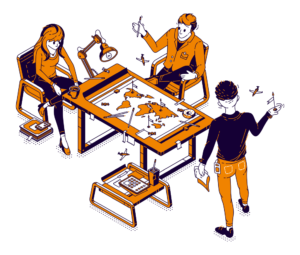
How standardisation improves our quality of living
In December 2021, the European Chamber launched its report, The Shape of Things to Come: The Race to Control Technical Standardisation, on China’s growing influence on the development of standards. Simon Lemin of TÜV SUD works in the world of standardisation, and testing, inspection and certification (TIC), and here explains the importance of the sector, not just in China but globally.

Each morning as I leave my apartment in Shanghai, I open my door and know that I won’t bump my head, as the national standard GB/T 5824-2021 defines the height of the doorframe. I press the button to call the lift and ride it down to the garage, knowing that GB 7588-2003 ensures that the lift doors will not crush me as I enter and exit. As I walk down the last few steps from the lift lobby into the garage, I know I won’t trip, as the height of each step is defined in GB 50096. I get my bicycle and cycle to the office, knowing that the bike is certified against the international standard ISO 4210 and so will be safe for me to use. When I arrive in the office building, GB/T 35153‑2017 ensures that I don’t slip on the tiles in the lobby, and EN 16516 is responsible for guaranteeing that the rug I bought from Europe for my office doesn’t emit benzene or formaldehyde.
You usually don’t even notice standards unless they’re missing, yet they affect almost everything. Without them, paper wouldn’t fit into printers (DIN A3, A4, A5), credit cards into wallets or containers onto ships. Sausages would constantly fall through the grates of the grill onto the coals and babies would choke on pacifiers they accidentally swallowed. Without standards, the same volume of international movement of goods—and globalisation as we know it—would be impossible.
Standards everywhere
The global pandemic has shown us all how necessary standards are. In 2020, when medical products and personal protective gear were in short supply in Europe, the European Committee for Standardisation and the European Commission developed relevant standards that they made available free of charge – such as EN 149, the standard for FFP2 protective masks. That meant European manufacturers were able to produce these goods quickly and in large quantities, as specifications like EN 149 provided the necessary guidelines, and governments and consumers could trust the products.
Standards are globally considered a seal of quality and safety. Along with national standardisation organisations such as Germany’s Deutsches Institut für Normung (DIN), there are also cross-border organisations such as European Standards (EN), and the International Organization for Standardization (ISO), which promotes consistency among international standards. The more abbreviations a standard uses—DIN, EN, ISO—the more organisations it has been verified by. Independent third-party TIC companies ultimately verify whether or not a product fulfils the requirements of the respective standard or standards.
Digitalisation is putting pressure on standards overall in this regard, since there currently aren’t many that are suitable for a lot of the new technologies. Today’s economy needs solutions for cybersecurity, blockchain, artificial intelligence (AI) and self-driving vehicles. It also needs to regulate interfaces for power grids that communicate with industrial items like machines or plant-systems, or household facilities such as air conditioners, heaters or refrigerators.
However, developing uniform testing methods and standards is a long and difficult process. For automated driving, for instance, there are still too many unanswered questions: Who is liable in the event of an accident? What happens if an autonomous vehicle must decide between hitting an old woman or a baby pram? The formation of technical standards must be preceded by a social and legal consensus on the issue, and currently society and politicians are still in the middle of these ethical and moral discussions.
A marathon, not a sprint
At the same time, the development and enforcement of globally-synchronised standards will determine the acceptance of technologies among manufacturers and consumers. A number of TIC companies have therefore founded the International Alliance for Mobility Testing and Standardisation (IAMTS). Research is also underway on how AI can be made safer, as well as not violating the fundamental rights of users, such as the right to privacy or equal treatment. This is important basic research: even for less complicated products, every standardisation process is more of a marathon than a sprint.
For example, in order to chaperone the process from an idea through to a finished standard, DIN has put together a network of 33,500 experts from business, science and research, consumer representatives and public authorities to discuss the pros and cons of each new standard before DIN recommends its application. Take the safety of school backpacks: the manufacturers of fluorescent and luminescent coverings sit face-to-face with consumers and independent TIC companies that can test whether the backpacks actually reflect light in street traffic. Even the wording in supposedly insignificant documents is haggled over in such meetings. The holy writ for such questions is DIN 820-2, which regulates how a standard must be structured, designed and written.
The battle of the standards
The world is becoming increasingly complex these days, and standards certainly help simplify certain aspects. They’ve become irreplaceable for businesses, since the time of industrialisation. That there were 25 variants for the valve of a steam locomotive at the turn of the 20th century is something that would be unthinkable today. And yet the criticism of standards never stops. “A common reproach,” writes technology historian Günther Luxbacher in a book about the DIN, “is that standards homogenised everyday life, that they ‘turned the variety of life’s beauty into a dreary sameness’.”[1]

A more serious accusation is that standards can be abused to make trade more difficult. So-called ‘non-tariff trade barriers’, like technical standards, that apply in target markets can impose expensive conformity or approval procedures on companies hoping to export their products – or even block them from the market entirely. Back in the 1930s, the American car manufacturers Ford and General Motors tried to introduce the American measurement system of feet and inches into the Ford and Opel factories in Germany. Similar disputes arose a few years ago between Germany and France regarding the charging plugs of electric cars: no uniform standards had been created and the French were bitterly opposed to the German plug configuration. It wasn’t until 2014 that the European Commission put an end to the dispute when it pushed through the ‘Type 2 plug’ standard, developed by the company Mennekes – a decision that set champagne corks popping at the firm.
The new power of standards
To this day, European carmakers have to adjust their products to American standards, whether it be the colour of indicator light or the characteristics of the windshield wipers. At the same time, foreign companies need to overcome similar standardisation hurdles in Europe as well. China represents another powerful player that has recently entered the standards arena. As noted in the European Chamber’s report: “China’s rapidly growing footprint in international technical standardisation is of particular significance given that its approach to standardisation is distinct from European and international practice.” While the Chinese previously acted more as observers, the report also notes that “internationally, China has made considerable efforts to increase its influence in standard setting in recent years.”[2] Alongside China’s involvement at the ISO in Geneva, where it wishes to add its contributions to global standards, this growing activity shows us that China’s strategic goal is to blanket large parts of the global economy with their own standards. While international/corporate competition used to be over patents, standards are now considered more important than protecting individual technologies that may ultimately prove unsuccessful. The aforementioned plug for the electric car is just one example, but everything else in the industry is connected to it, including the cars, the infrastructure of the charging stations and the energy suppliers. The same scenario is being played out with numerous technologies across numerous industries.
Simon Lemin is director of the Industry Segment of the Industry Service Division, Real Estate and Infrastructure Division at TÜV SÜD Greater China. Simon focusses on risk reduction through TIC for areas such as green energy and sustainability, real estate and infrastructure, chemicals, rail, and high-risk products like pressure vessels.
Simon
is also an active member of the European Chamber’s Energy Working Group and the
Environment Working Group in Shanghai.
[1] Luxbacher, G., DIN von 1917 bis 2017: Normung zwischen Konsens und Konkurrenz im Interesse der technisch-wirtschaftlichen Entwicklung, Beuth Verlag, Berlin, 2017.
[2] The Shape of Things to Come: The Race to Control Technical Standardisation, European Union Chamber of Commerce in China, 2nd December 2021, < https://www.europeanchamber.com.cn/en/publications-standardisation-report>


Recent Comments